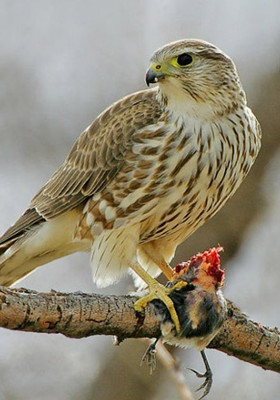Merlin (Falco Columbarius)

| Order: | Falconiformes |
| Family: | Falconidae |
| Subfamily: | Hierofalco |
| Genus: | Falco |
STATUS:
Introduced to CITES appendix II. This species is not endangered, the possibility of receiving permission for its capture and housing is not excluded.

The Merlin is a fairly common wintering bird in Uzbekistan, sticking to the plains and low mountain landscape. The stocky falcon, a little smaller in size than the Kestrel has relatively short, pointed wings and a tail much shorter than that of the Kestrel. Their body length is 24-32 cm, wingspan 53-73 cm, with females being on average one-third larger than males. The bird’s weight is 160-311 grams, whilst the male’s is only 125-235 grams. The two sexes differ in their appearance too. The male’s top body is blue-grey, sometimes with a purple or brownish tint, with black longitudinal streaks on the head, neck and shoulders. His underbelly ranges from from cream to red with large longitudinal brownish-black strokes. On the neck there is light circle, giving the impression of a light collar. This falcon’s 'whiskers' are mild in colour and tone. The flight feathers are grey-brown with an ochre cross pattern on the inner webs. The tail is striped with a dark broad band at the end. The life expectancy of a Merlin in the wild is typically less than 11 years.
Spring migration for Merlins (through Uzbekistan) is mainly in March and early April, with only a few individuals leaving later. The earliest appearance of a Merlin in Uzbekistan has been September, although October and November are more likely. It lives in all the lowland and foothill areas of the republic, keeping to the shores of ponds, oases, copses and gardens.
This bird of prey nests in Northern and Eastern Europe, the forest and steppe zone of Asia and North America. Like most migratory birds, wintering to the west and south of the breeding range and in some cases reaching the tropics. Merlins prefer to inhabit open space; river valleys, steppes, forests, sea coasts, shrub tundra, the margins of peat bogs, moors, sand dunes. They will avoid thick, dense woods, however, during the breeding season, often found on the edges. The most common in the forest-tundra and northern taiga zone, where it reaches the maximum number.
A Merlin’s flight is somewhat like that of a swallow; fast and manoeuvrable, with frequent alternation of shallow wing strokes and dives. It hunts low over the ground, looking for prey in the air or on the ground, among low-growing vegetation; during a dive it will shoot through the air with folded wings. It prefers to eat mostly small birds; sparrows, larks, swallows, shorebirds, blue throats, wagtails, redpolls and thrushes. To a lesser extent it eats rodents, lizards, small snakes and insects. On migration there have been cases of it hunting large dragonflies. Outside the breeding season, Merlins sometimes hunt in pairs, with one bird flying at a low altitude, and the other at 10 to 20 m above it.
The female Merlin will lay a clutch of three to four eggs that are ochre in colour, that are speckled with large reddish-brown spots. Dimensions of the eggs are 37-42 x 29-33 mm. Both parents take turns at incubating the eggs. The incubation period is 25-32 days. At birth, Merlin young are covered with sparse white down, which in a few days, is followed by another, greyish-white, denser down. The male and female care for the chicks together; keeping them warm, providing food and keeping the nest clean and comfortable. After two weeks the chicks start to grow early feathers, and leave the nest on their own, however they are still unable to fly. After about 18 days the down is completely replaced by the the first nesting plumage, and after 25-30 days the young birds are in the air, although initially they fly a little reluctantly. Young Merlins become fully independent at the age of six weeks.
Many falconers believe that hunting with a Merlin simple, but this is not the case, for catching small birds is the most difficult task in falconry. To explain the nuances of hunting with a Merlin is very difficult. If you want to work with a Merlin, it is better to contact a falconer who hunts specifically with this type of bird of prey. One day in the field with a professional will save you large amounts of frustration.
1. Meklenburtsev RN, Sagitov AK Kashkarov DY, Mitropolsky OV ER Fotteler, Tretyakov GP, Ostapenko MM Nazarov, AP Birds of Uzbekistan, including Tashkent 1. ‘Fan’ of the Uzbek SSR. 1987.
